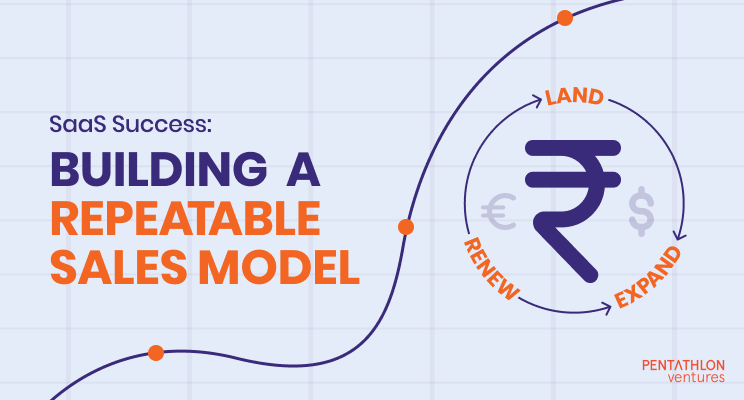Around six months ago, I was talking to the Founder of a leading deep tech company. He lamented that he was spending nearly 80% of his time chasing and converting leads.
The progress was steady, but not fast enough. Despite having two full time sales people onboard the Founder kept getting pulled into every single sales opportunity.
That’s how we got talking about building a repeatable sales model. Even since the Founder put this new model in place, his sales force has become productive and sales targets are being met. But crucially, the Founder was able to focus the vision and roadmap once again!
Here are some key takeaways from the repeatable sales model discussion:
Connectors and Networks
It goes without saying: The initial sales of most B2B startups are almost always Founder-led. This is where the first degree connections come in handy — these are people willing to pilot your product because of the trust and relationship with the Founder. Assuming you delight the customer, it’s a relatively easy conversion from pilot to sale. At this point the Average Selling Price (ASP) doesn’t matter as much as the ‘logo’, because this is what you will be using to convert other prospects into paying customers.
But there’s a problem: a Founder from India usually doesn’t have a large network in the US — the largest SaaS market in the world. Also, unlike consumer products, enterprise products rarely go “viral”. So investing in building out a network is critical.
A great source of prospects are your investors — don’t hesitate to ask for warm introductions, which puts you on the inside track to closing deals. At VeloCloud Networks, our Series A and Series B investors helped us secure many first meetings with decision makers. We were able to make a compelling case for our service and value we provided and convert many of these into those crucial initial sales. But it would not have been possible if we could not get our foot in the door.
LinkedIn is another great resource to research the network of your first contacts. Current customers, investors and direct LinkedIn contacts can help build out your network and prospects. Another way a Founder can systematically build out a network is to ask each happy customer or successful pilot for introductions to their network. Played right, the network here can be exponentially scaled.
Converting these prospects into actual pilots and sales, requires you to build out a Sales Team to accelerate your growth.
Building a Sales Team
In the previous article Achieving Success with SaaS Enterprise Sales, we spoke about hiring a sales champion who leads and pioneers sales. The Founders and sales champions will get the messaging and pricing right along with the pitch deck.
With training, each new sales person you hire must be able to take this to market and win deals.
But in a team, it is important that each new hire has their own territory, so you can gauge how each sales person is faring and see what techniques work. This will help you fine tune and replicate working approaches.
In addition, each win and loss must be reviewed carefully to identify product gaps. You will never have the resources to add all the bells and whistles but you must make core enhancements to the product for continued success.
Products with high ASP (USD 100K+) typically require multiple follow-ups and in-person visits, now that Covid restrictions have largely been eliminated in the US. While marketing and demand generation remotely can happen from anywhere in the world, the biggest sales wins come with a local salesforce. Never underestimate the cultural angle and hobnobbing required to make sales materialise.
Collateral
There are a few things that are indispensable to anyone getting in front of a customer. This includes collaterals like the updated sales deck, customer references and case studies. Consider engaging companies like Zoomfier which can both develop and quantify engagement with current and potential customers.
Imagine playing a crucial match in your favourite sport. You wouldn’t be without your trusted gear. Similarly, when you go to a critical sales meeting, be prepared, else you may not get a second opportunity — you may have to win over a sceptical client who may have their biases.
If you are displacing an incumbent vendor, your presentation needs to be even more compelling highlighting what you do better than the competition. Prep your sales team by updating your presentation regularly, so that it shows your product value and addresses the FAQs. Slide 10 in the original 2007 Dropbox pitch deck gives a good example of how to compare yourself with potential competitors.
Case studies: Convert some of early sales into case studies that you can share with prospective clients. Make sure that you select them carefully and have a sampling of verticals. A good marketing department will lead the way here.
Industry analysts & reports: A good marketing team will also reach out to industry analysts, establish a good rapport and make the case for your fledgling startup. Analyst reports are frequently consulted by large enterprises to create shortlists of vendors – and your early attention here can help reap windfall benefits down the road. For example, customers refer to Gartner reports and Magic Quadrants and ask you to juxtapose your service against existing Leaders and Visionaries. A good example of a vendor showcasing analyst report favorable to them can be found in https://sase.vmware.com/resources/gartner-magic-quadrant-for-sd-wan-2022
Website: Needless to say, a snappy website which makes browsing and learning a pleasure should be high on your list.
Sales Leads
The movie Glengarry Glen Ross is the best example of how Sales & Marketing can sometimes work at odds with each other. Truth is sometimes stranger than fiction — and it’s not uncommon to see scenes like that in offices. Founders and CEOs have to lead the way in ensuring that 50% or greater of the Marketing Qualified Lead (MQL) actually result in pilots or sales.
Great sales teams know they need to map out the internal organisation of the client in the very first meeting and identify key decision makers and the available budget. Asking for this information point blank (respectfully, of course) works best. Sales meetings are not the time to be coy and diffident.
Ultimately everybody wants a deal, so an online ROI tool which can be demonstrated to the client during a meeting is huge. Invest in it and make it available to anybody who will give you the time of day. An example of a simple and excellent ROI calculator is available at https://www.ooma.com/home-phone-service/savings/.
After Sales Services
Going from a verbal agreement to a signed Purchase Order can take a week or can take months. Enterprises in the US often prefer using their own purchase agreements. You can work to keep this part of the cycle short, by having sufficient legal staff who can negotiate the nitty-gritty and get to a quick resolution.
While you cannot control the customer’s responsiveness, you can incentivise them to close it quickly and ensure that your legal staff is on the ball. Outsource the legal work if you have to, but don’t let the lack of a legal team become the bottleneck.
In a SaaS business model, after sales service means perfecting the ‘land-expand-renew’ cycle. If customer retention is a problem, it jeopardizes the expand-renew cycle and your ARR will never increase at the rate at which you or your investors desire.
But ‘Expand and Renew’ will only happen if:
a) Your customer is actively using the product
b) They are happy with the quality and responsiveness for any issue they raise, So invest in a customer success team which provides holistic service to the customer. If you are small, your engineering team can serve as the customer success team till you are able to hire specifically for this task.
Summary
For SaaS companies, building a repeatable sales model in the US means getting a few things right. Leveraging your extended network of contacts and investors to get your first customers onboard, hiring a competent sales team with their fundamentals in place, and making sure you don’t drop the ball when it comes to after sales service!
Above all, it means focusing on customer retention to perfect the ‘land-expand-renew’ cycle to make sure your ARR grows at the expected rate!
Until next time,




